Insulated Metal Panels: An All-In-One Air and Water Barrier
Ideal for both retrofits and new construction as an all-in-one air and water barrier with continuous insulation, roof and wall insulated metal panels deliver a plethora of performance, erection, durability, and aesthetic benefits
![]() Continuing Education
Continuing Education
Use the following learning objectives to focus your study while reading this month’s Continuing Education article.
Learning Objectives - After reading this article, you will be able to:
- Identify the role of prefabricated insulated metal panels (IMPs) as an all-in-one water and air barrier enclosure with continuous insulation.
- Compare the construction benefits that IMPs deliver via a more simplified, cost-effective, and time-efficient erection process in addition to enhanced safety and less required manpower in the field.
- Describe the key full building enclosure, structural, and fire-performance attributes of IMPs.
- Explore the versatility and performance attributes of IMPs for retrofits and recladding.
As an all-in-one prefabricated building enclosure, delivering full water and air protection, with continuous insulation to boot, insulated metal panels are a great option for most commercial and industrial buildings.
Whether it’s office, health care, schools/higher education, retail, convention centers, stadiums, airports, light manufacturing, warehouses, food processing facilities, freezer buildings, and others, IMPs deliver a plethora of energy efficiency, durability, and aesthetic advantages.
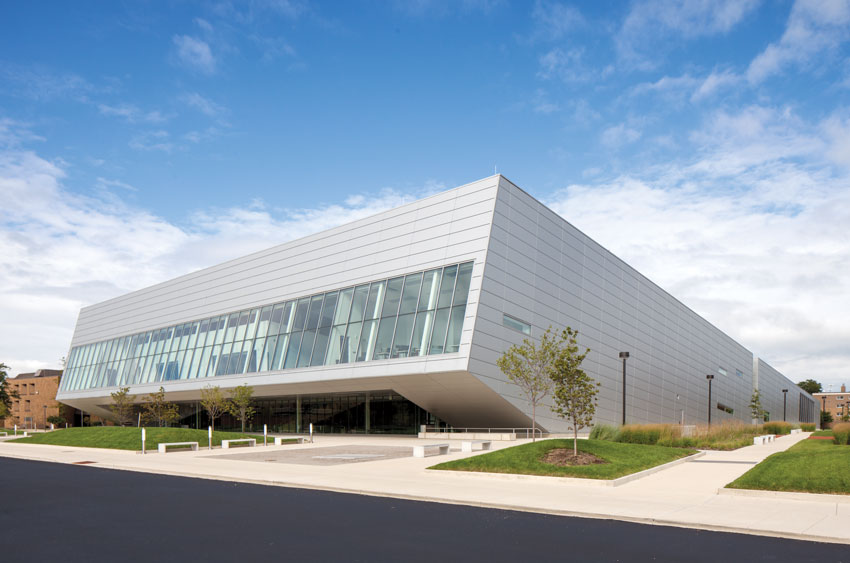
Photo courtesy of CENTRIA
Architectural IMPs not only deliver high insulation values, speed of build, vertical and horizontal applications, but they also offer custom shapes and widths, colors and finishes, and fabrication, including but not limited to bent corners, curved panels, and trimless ends.
Thanks to its insulating foam core sandwiched inside two sheets of coated metal, with no metal conductance from the exterior to interior skin, IMPs register the highest insulating value of any cladding material on the market. Delivering an aged R-value of 6.2 to 6.7 per inch vs. the 4.5 per inch for batt insulation, performance is essentially doubled, enabling projects to meet prescriptive insulation code requirements and those mandated by ASHRAE 90.1. (Note: ASHRAE is not a code, it is a standard that can be adopted by codes).
“These high-performing wall and roof systems increase overall thermal comfort for building occupants, while reducing energy consumption and wear and tear on mechanical HVAC equipment,” reports R.C. Antal, insulated panel manager, ATAS International Inc., Allentown, Pennsylvania, and Metal Construction Association (MCA) IMP council member.
Furthermore, most polyisocyanurate and polyurethane foam cores used in today’s panels have zero ozone-depleting potential and offer enhanced physical performance.
“Separate materials installed individually have greater potential for failure points,” says Tim Keil, RA, associate principal with the Phoenix-based architectural and environmental design firm Studio Ma. “As a single system, IMPs can improve weather and airtightness, which are key for high-performance buildings.”
But beyond its role as a sealed air, water, and vapor enclosure with excellent thermal properties, building teams can also cash in on multiple construction benefits with IMPs.
For starters, IMPs install in one step—as a finished wall, insulation, and liner—allowing the construction team to dry-in the building faster than conventional construction methods, according to Kim Harrell, vice president of sales, All Weather Insulated Panels, Vacaville, California, and an MCA IMP council member.
As opposed to conventional stud construction, for example, which requires contractors to wait for the sheathing, building wrap and insulation from multiple trades to be installed prior to interior finishing, IMPs are a one-shot building enclosure installation, significantly shortening project schedules and construction expenses, states Don Olsen, vice president of operations with the Hartland, Wisconsin-based A/E firm ESI Design Services.
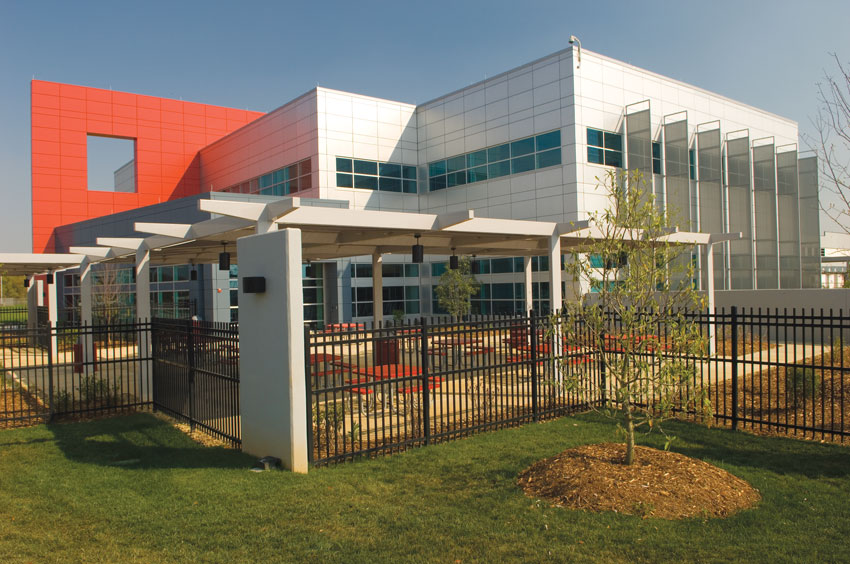
Photo courtesy of CENTRIA
IMPs are ideal for all types of commercial and industrial buildings, including institutional, recreational, governmental, and manufacturing facilities.
As spelled out in MCA’s Selection Guide for Insulated Metal Panels, IMPs can be erected at a rate of up to 5,000 square feet per 8-hour shift by a four-man crew on an industrial project, and up to 1,100 square feet per 8-hour shift by a four-man crew on an architectural project.
And unlike some cladding materials, IMPs can be installed year round, even in adverse weather conditions.
“One of the major advantages of IMPs is that they typically do not need extensive backup walls or support system assemblies, while still meeting code requirements,” adds Deniz Ferendeci, AIA, LEED AP BD+C, director of building services, Dyer Brown, Boston. “The majority of these products are self-supporting, which means installation is faster and less complicated.”
In terms of aesthetics, IMPs are a far cry from the technology’s original origins dating back to the 1960s, when IMPs were considered purely utilitarian and used to clad mechanical penthouses and other less-visible applications, according to Ferendeci.
On the contrary, today’s IMPs come in stucco, woodgrain, and metallic finishes, with a wide variety of panel profiles from flush to deep ribbed to curved. With the fairly recent inclusion of polyvinylidene fluoride (PVDF) resin-based paint coatings, IMPs now benefit from exceptional color, durability, and chalk and fade resistance.
“The ability to be customized in color, size, and pattern makes IMPs an economical method of providing a unique design expression, while satisfying the need for continuous insulation and exterior finish, all in one system,” summarizes Robin Edward Whitehurst, AIA, NCARB, LEED AP, technical principal, Bailey Edward, Chicago.
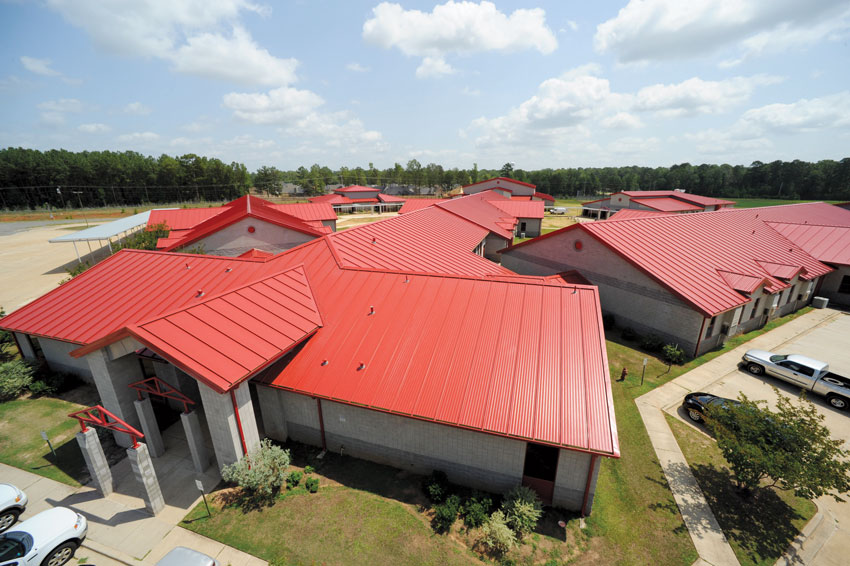
Photo courtesy of Metl-Span
Based on its thermal insulation properties and speed of erection, Newman Marchive Carlisle architects specified more than 130,000 square feet of insulated metal panels to reroof Haughton Middle School’s eight-building campus in Haughton, Louisiana.
Recognizing IMP’s aesthetic benefits on a deeper level, Saul Jabbawy, principal, director of design, EwingCole, Philadelphia, acknowledges breakthroughs in manipulating the metal’s surface to create a 3-D design, a wide variety of micro textures and colors, applying printed, films, or paints to mimic a variety of appearances, and the ability to create complex patterns and surface textures.
While non-insulated metal panels provide even more flexibility, their added cost as part of a rainscreen makes them an easy candidate for value engineering, whereas IMPs play triple duty as air and water barriers with insulation, helping them survive the VE process.
Furthermore, a good number of quality IMP manufacturers in the marketplace have created a healthy competition, providing architects and building owners with a greater opportunity to explore custom colors and finishes at a competitive price point.
“Additionally, the widespread use of these materials means there is now a great deal more data on long-term performance, assembly fire testing, and installation precedents,” Keil notes. “This is extremely helpful, especially when project budgets dictate we specify off-the-shelf solutions.”
How IMPs are Manufactured
How do IMPs achieve a high level of thermal insulation performance, durability, and dimensional stability? It all starts with a sophisticated manufacturing process where polyisocyanurate foam is injected, as a liquid or froth, in between two sheets of coated steel or aluminum. Responding to a chemical reaction, the foam then expands to fill out the cavity, ultimately producing a panel capable of delivering a stable thermal value and resisting moisture and insect/rodent infiltration.
Finally, the panels are cut to length, with some manufacturers treating the panels’ cut ends as well.
In terms of dimensions, wall panel thickness ranges from 2 inches to 6 inches, width runs from 24 inches to 42 inches, and IMP wall panel length starts at 1 foot and extends to 53 feet. Facings are made from aluminum, galvalume/zincalume, G-90 HDG steel, stucco-embossed steel, aluminum, and zinc. Gauge ranges from 22 to 24 for gauge steel and 22, 24, and 26 for gauge-coated steel.
For roof panels, thickness is also between 2 and 6 inches, with a standard width of 36 to 42 inches. IMP length is available from 8 feet to 52 feet; panel facings include galvalume, zincalume, and prepainted steel; and gauges come in 24 to 22 for the exterior and 22, 24, or 26 for the interior.
But the real secret of IMP’s outstanding thermal performance levels is the polyisocyanurate foam.
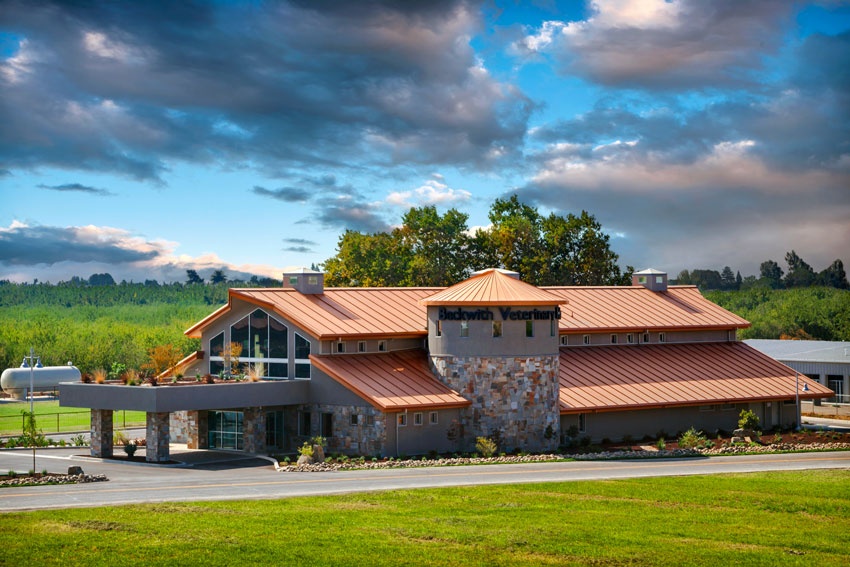
Photo courtesy of Kingspan Panels
Utilizing state-of-the-art technology, IMP roofs bind interior and exterior steel facings to a polyisocyanurate insulating foam core.
According to the Polyisocyanurate Insulation Manufacturers Association (PIMA), the foam offers the following attributes:
- Thermally efficient rigid board insulation with highest, long-term R-value per inch of thickness
- Moisture-resistant foam core
- Compatibility with most solvents used in construction adhesives
- Excellent dimensional stability
- Superior performance in fire tests
- Wide range of service temperatures
- CFC- and HCFC-free with zero ozone-depletion potential
- Recycled content in most products
- All insulated metal panel producers are either making panels with negligible global warming potential or transitioning to that technology in the next few years.
The Building Enclosure
Not only do high levels of thermal performance contribute to continuous insulation requirements, but IMPs are well tailored for supporting high-performance building enclosures as well.
As John Straube, Ph.D., PE, principal, RDH Building Science, Toronto, explains in his white paper Controlling Air and Rainwater Using Insulated Metal Panel Enclosure Systems, IMPs are one of only a few types of building products that can provide an entire building enclosure in one prefabricated product.
“An insulated metal panel system can be used on its own to provide a complete enclosure, added over a lightweight structure and interior finish in new construction, or added over an existing enclosure to provide a new level of enclosure performance,” he states.
To better understand the role of the enclosure, Straube describes its role as the “skin” separating the interior environment from the exterior, thereby serving as an environmental separator. He further defines the enclosure as providing the following three functions:
- Support: Resisting, transferring, and accommodating all structural loading imposed by the interior and exterior environments, by the enclosure and by the building itself
- Control: Blocking, regulating, and/or moderating all loadings created by the separation of the interior and exterior environments, i.e., the flow of mass (rain, air, water vapor, pollutants, etc.) and energy (heat, sound, fire, light, etc.)
- Finish: Surface finish at the interface of the interior and exterior, meeting visual, aesthetic, durability, and other performance requirements
“Unlike the superstructure or the service systems of buildings, the enclosure is always visible and therefore of critical importance to owners, occupants, and the public,” Straube says. “The appearance and operation of the enclosure has a major influence on the interior environment and on factors such as comfort, energy efficiency, durability, and occupant productivity, satisfaction, and health.”
Killing several birds with one stone, the composite panels within the IMPs provide both the support and control functions, and, in many cases, the interior and/exterior finish as well.
In terms of water penetration, Straube explains that while the exterior location of the water barrier exposes it to weather, it simultaneously provides a number of advantages. In addition to the fact that coated steel—frequently used in IMPs—is quite durable, the barrier prevents water from entering the enclosure and can easily be inspected.
Fortunately, William McCrory, AIA, LEED AP, architect, SmithGroupJJR, Phoenix, points out that IMPs’ panel-to-panel connection with their built-in gaskets or sealants allows for a seamless and airtight nesting. That said, special care must be taken in the detailing of transitions to different kinds of wall systems. To assist with this, proprietary window systems—offered by some IMP manufacturers—allow for seamless integration of panels with punched openings.
To best ensure proper performance of water-resistive, vapor, and air infiltration barriers, Antal instructs, “It is critical that the system is properly sealed with the use of non-skinning butyl sealants. This is achieved by applying non-skinning butyl sealant to all perimeter areas of the support steel at panel ends and at all panel interlocks.”
Offering a couple design tips, Jabbawy recommends detailing the transitions to other materials and openings, and verifying continuity of thermal, air, and moisture barriers. In addition, site visits should help ensure the installation meets the design intent and reflects the shop drawings.
IMP systems must also be fastened back to a primary structure, typically with fasteners and clips, in order to safely and effectively transfer the collected loads, says Straube. “The design of these details and the construction of the IMP enclosure must account for these special penetrations, or leaks of air and rainwater may occur.”
“While the panels are manufactured with internal gaskets/seals to prevent the intrusion of water, care must be taken with the vertical joints, especially at the heads of openings, at the base of the wall, and at the intersection between a wall and roof,” Olsen adds. “With the proper use of counter flashings and sealants, water infiltration is not a problem.”
While mechanically clamped gaskets and membranes perform exceptionally well for joints between an IMP and another building component, they are often practically difficult or too labor intensive to effectively install between panels.
In general, “When designing joint details, it is recommended that the outer metal sheet be considered the water control layer and the inner sheet liner be designed as the air-control layer,” Olsen says.
Selecting IMPs
When selecting and specifying IMPs, architects take a number of factors into account, such as span capacity, panel layouts, water tightness, material quantities, attachment points, exterior metal surface appearance, and, of course, cost.
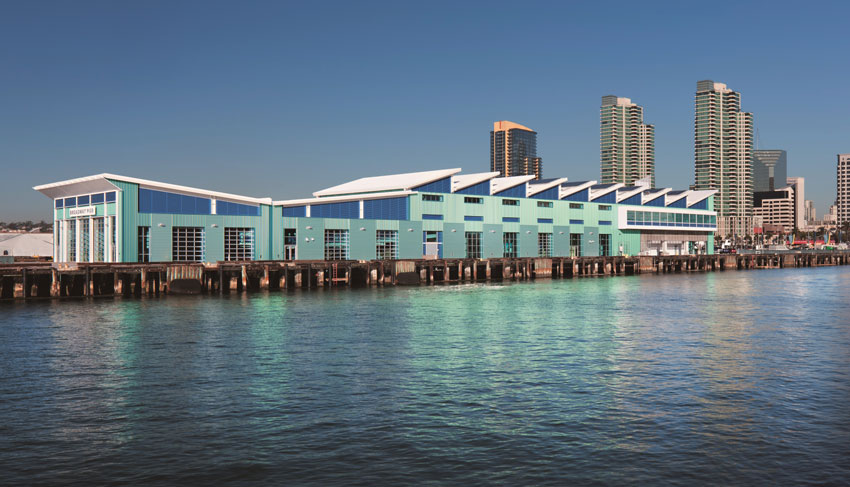
Photo courtesy of Kingspan Panels
Port Pavilion on Broadway Pier in San Diego is an example of an award-winning municipal project that incorporates insulated metal panels, metal roofing, and metal wall panels.
“Typically, we will write a performance specification around a ‘basis of design’ for a product and manufacturer that meet our requirements. Then the manufacturer/subcontractor marketplace actually determines which product is most affordable at the time of bidding,” explains Kevin Krumdieck, AIA, LEED AP BD+C, principal, architect, Carrier Johnson + CULTURE, San Diego.
Essentially, it’s always a matter of cost, performance, and aesthetics on every project, but in different ratios, Keil explains. “For the projects that are especially cost conscious, we’ve become adept at pushing the budget-friendly cladding systems as far as we can to create something new and unexpected,” he says. “We seek out manufacturers who are willing to work with us to explore ideas.”
Similarly, EwingCole looks for manufacturers that provide the most versatile product in terms of design and customization, in addition to meeting high levels of insulation and airtightness.
For Bailey Edward, the architects typically review literature and test reports from a number of manufacturers, in addition to samples of each product. “We will also visit local installations of products similar to the system we anticipate utilizing, if available,” Whitehurst reports. “Once we have identified candidates, we will compare standard system details provided by the manufacturers with our exterior wall designs for compatibility and their ability to achieve our design goals.”
Whitehurst also recommends selecting the IMP system based upon the building type and required materials.
In terms of verified performance levels, specifiers should make sure that the IMP product has passed certain standard tests. As delineated in MCA’s Selection Guide for Insulated Metal Panels, IMPs carry ratings for fire, structural, thermal transmittance, water leakage, air pressure differential, and foam core properties.
For example, the foam core should be measured for density, shear strength, tensile strength, compressive strength, humidity aging, heat and cold aging, and flash and ignition properties. ASTM C 1363 tests the insulated metal panel R-values in 1-inch intervals. IMP wall panel systems range from 2 inches to 6 inches thick.
Incidentally, according to MCA’s Guide, IMPs require a thickness of just 3 to 33/4 inches to achieve an R-value of 20, as compared to glass fiber with a separate liner, sub girt, and fascia, which must be approximately 7.5 inches thick to reach the same R-value.
Essentially, by choosing IMPs, building owners are then afforded a significant increase in useable floor space.
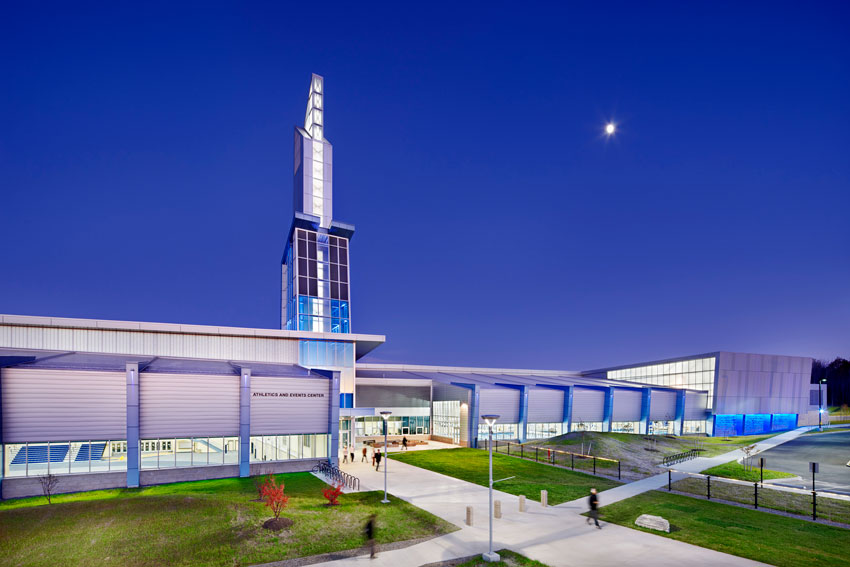
Photo courtesy of 3A Composites USA Inc./CENTRIA
The Ithaca College New Athletics and Events Center in Ithaca, New York, is clad in insulated metal panels, metal wall panels, and metal composite panels.
Furthermore, the composite action between the flat skins and the foam core produces a very structurally strong product, enabling a typical 2-inch panel to meet most 20 to 30 psf wind load requirements with 7-foot to 10-foot span conditions.
Offering some key installation instructions, the Guide emphasizes that penetrations be kept to a minimum. For small penetrations, “boots” or stack flashings are recommended for sealing, while a factory-welded curb with additional structural support is best for larger roof penetrations.
Maintaining proper back seal or liner-side seal continuity requires proper panel support alignment, and this alignment also helps avoid stress-induced panel face distortions. Ultimately, the support alignment should not deviate more than ¼ inch in any 20-foot length in any direction.
In order to ensure water infiltration performance levels, a proper seal system is imperative. Most commonly, a non-skinning butyl sealant is applied on the structural steel at panel ends, which are connected to either shop- or field-applied sealant located in the panel side joint. “The result is that each panel has a complete perimeter of butyl sealant on the liner or warm side, which in turn creates an excellent vapor barrier,” instructs the Guide.
Another key point is ensuring that the fasteners are compatible with the IMP substrate. Otherwise, corrosion between dissimilar metal types can occur, thereby potentially damaging the integrity, performance, and aesthetics of the IMP system. To best prevent this, the Guide advises that fasteners be made of the same material as the wall system whenever possible, or minimally, that the fastener offers equivalent corrosion resistance to the material it is fastened to.
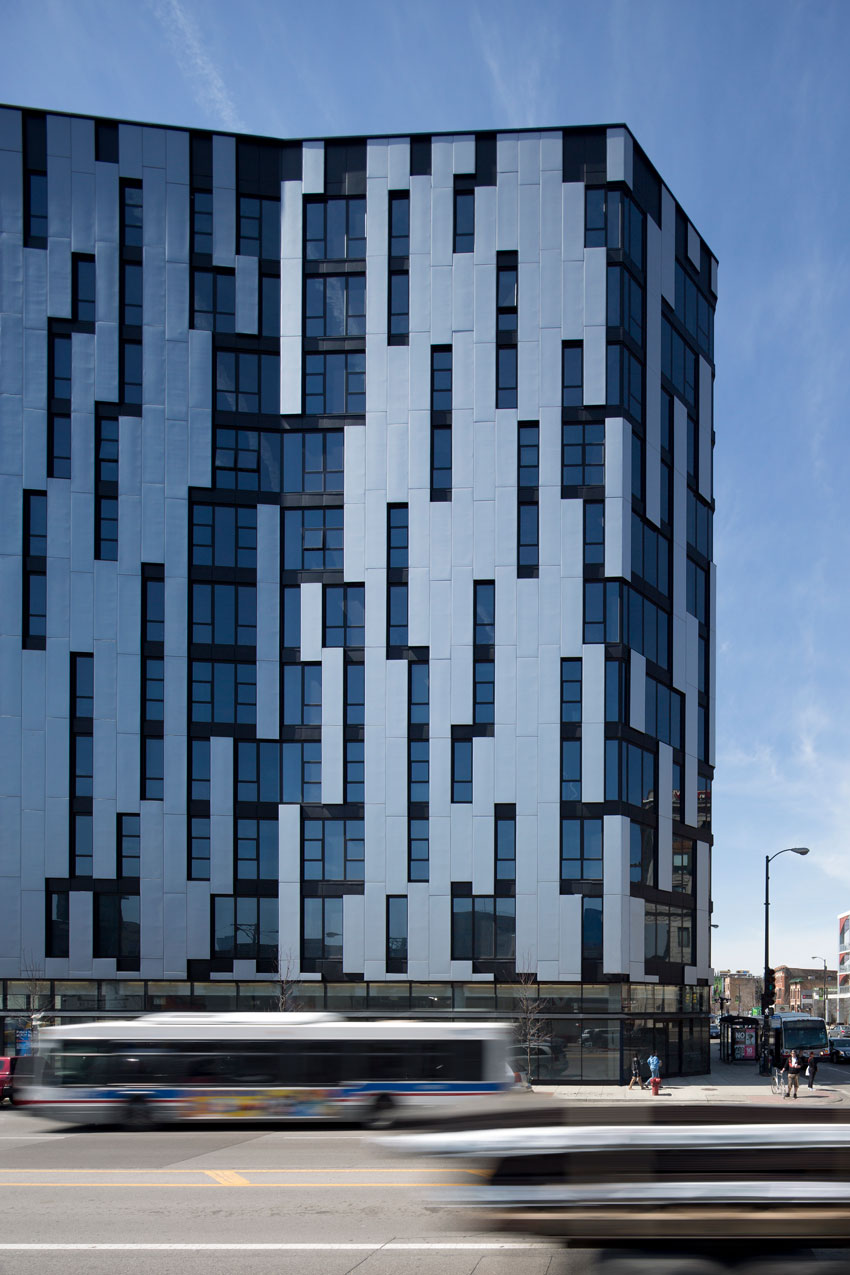
Photo courtesy of Kingspan Panels
A Metal Construction Association Chairman Award in the residential category, insulated metal panels create a striking facade at the 1611 West Division Apartments in Chicago.
Structural Loading
Among the many features proffered by IMPs, the panels do a good job of resisting transversely applied loading, defined as loading applied normal to the face of the panel. This includes wind loading, and for roof panels, live/dead/snow loading as well.
Because the panels are separated by an insulated core, IMPs are also capable of resisting thermal loading that can be induced when the face and liner sheets are at different temperatures.
As explained in an MCA Technical Bulletin, “Insulated Metal Panels – Structural Loading,” despite these performance capabilities, IMPs are not considered “load-bearing” panels in the sense of axial loading. However, they can be used on a load-bearing wall, but only if the axial load is carried by other construction, not by the panels themselves.
Because many IMP products incorporate a progressive tongue-and-groove interlock joint, they are hard fastened to the structure along their leading edge. As a result, these side joint-fastened panels exhibit low resistance to racking type loads.
While IMPs offer these structural advantages, they must undergo a complete structural analysis as nonhomogeneous structural beams addressing the following five basic modes of failure: flexural buckling of the metal facings, shear failure of the core, excessive deflection, clip/fastener failure, and connection failure.
MCA further explains that when placed under a shear load, the foam core cells will elastically deform, to a certain degree, which can cause additional deflection, redistributing reactions among the supports and altering conventional beam analysis equations.
“Accurate structural analysis is best performed by the panel manufacturer’s design team or by an independent design professional familiar with composite foam panel design,” instructs MCA.
Putting things into perspective, a maximum panel deflection of L/180 is common for wall applications. However, the 2015 International Building Code allows a maximum deflection of L/120 for walls with a flexible finish. For IMP roof applications not supporting the ceiling, up to L/180 is generally acceptable. When the panels are supporting the ceiling, panel deflection is limited to between L/240 and L/360.
Sustained loading, such as a long-term snow load, can cause additional shear deflection, but fortunately, IMPs are quite resilient and will return to their flat position soon after the transverse load has been removed.
Taken together, IMPs contribute to a strong building enclosure, often capable of supporting spans of 10 feet or more between supports. “The composite bond of IMPs produces a building unit that is much stronger than the individual components, even with very light gauge facings,” states the MCA Bulletin.
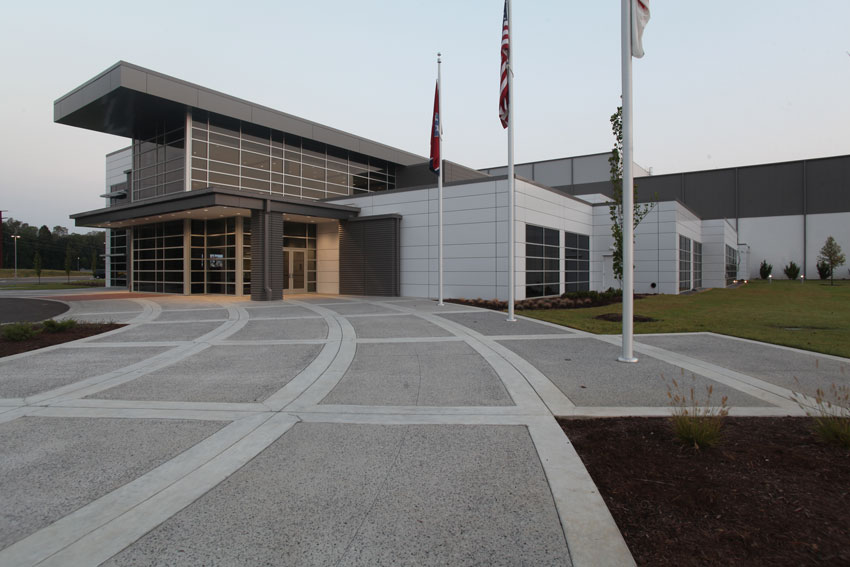
Photo courtesy of Kingspan Panels
The Utah Paperbox Co. in Salt Lake City is faced with insulated metal panels.
IMPS and NFPA 285
When specifying insulated metal panels, architects should be aware that the product’s foam insulation ingredient makes it subject to NFPA 285 fire propagation restrictions per the International Building Code. This applies to plastic foam insulation that is used on exterior walls for Type I, II, III, or IV construction.
The good news—as Jesse J. Beitel, senior scientist, principal, Hughes Associates, and the code and fire consultant to the Exterior Insulation and Finish Systems’ Industry Members Association reports in MCA’s white paper “Insulated Metal Panels and NFPA 285”—is that based on test data and Beitel’s experience with IMP panels in NFPA 285 tests, IMPs generally exhibit very good fire performance.
The 30-minute fire test—“Standard Fire Test Method for Evaluation of Fire Propagation Characteristics of Exterior Non-Load-Bearing Wall Assemblies Containing Combustible Components”—evaluates the level of vertical and lateral flame propagation emanating from plastic foam insulation inside the IMP via visual observations and temperature measurements throughout the wall assembly.
As a helpful guide for architects, Beitel lists the following IMP characteristics that may need to be evaluated during NFPA 285 testing:
- Foam plastic core insulation formulation, which varies amongst manufacturers, and the maximum density and thickness contemplated for use
- Facings, evaluated using the minimum thicknesses contemplated for use and the metal type on the facers
- IMP panels size
- IMP panel orientation
- IMP profiles: Typically, a flat profile is evaluated, although other profiles would be acceptable, assuming the thickness of the foam plastic core insulation remains below the maximum flat profile tested and that the joint system is similar.
- IMP panel joints: Typical joints are overlapping joints with concealed fasteners, clips, and caulk. Minor variations from the tested assembly are allowable.
- Attachment system: As the most common system, a light gauge metal steel frame is tested.
- Window/trim details: The window header, jambs, and sill in its “simulated” window opening must be sealed so that the foam plastic core is not directly exposed.
- Use of thermal barrier: Typically, ½-inch-thick gypsum wallboard is used on the interior side of the wall assembly, must be installed over the full height of the wall assembly, and cannot stop in what would be the space above a drop ceiling.
As an alternative to NFPA testing, building code officials and authorities having jurisdiction will potentially accept engineering judgement letters regarding fire-resistance assembly ratings, per the IBC, where appropriate.
“Since every variation of a wall system cannot be tested, and based on the discussions above, if the ‘basic’ IMP panel system meets NFPA 285, minor variations in items such as caulks, trim, window details, and joints can be allowed without retesting or an analysis,” states Beitel in MCA’s white paper.
Ready-Made Retrofits
Among the numerous commercial, industrial, and institutional applications benefiting from IMPs, the technology is particularly suitable for retrofits as well.
“Advantages include the potential speed of erection, the thermal performance gains from adding a new insulation layer and very good thermal breaks, and the capability of the system to provide large panel size and span,” states Krumdieck. “In particular situations, the IMP panels can also provide both the exterior and interior finish, which could reduce overall wall or roof assembly costs.”
“IMPs are a good choice for retrofits due to the one-step application and fast construction time in replacing existing roof and wall systems,” agrees Harrell. “They can provide a fresh look for tired buildings and are a substantial upgrade in building performance.”
Furthermore, Jabbawy notes that because the product is lightweight, it can replace most existing masonry envelopes without structural changes. And because IMPs are offered as prefabricated large units, they can meet expedited erection schedules, which is often a critical factor for retrofits.
“Also, since the system provides both the surface closure and the insulation element of the envelope, it allows for the application of the material on top of existing envelope construction or even as a replacement for existing construction, while minimizing the trades involved in the envelope building sequence,” he adds.
Case in point, on a recent retrofit pursuing LEED certification with requirements to meet stringent energy code requirements, Studio Ma realized that continuous exterior insulation using another system would have been too difficult and costly. In selecting IMPs, the contractors were able to install the new cladding from the existing floor, achieving the required energy and weather performance, with a nice aesthetic to boot.
On Bailey Edward’s docket, the firm recently renovated a college academic building, capitalizing on the ability to provide both an exterior finish and continuous insulation over an exposed steel frame.
“We saw a dramatic decrease in energy transfer from the interior to the exterior as evidenced by infrared thermography of before and after the reclad,” relates Whitehurst. “We utilized the panels to cover the existing ceramic tile on concrete block and exposed steel, and as spandrels above and below a new curtain wall system.”
On another retrofit project for California’s Department of Motor Vehicles in Sacramento, IMPs easy installation helped enable the site to continue functioning throughout the large campus-wide retrofit.
As part of a major $130-million LEED-certified upgrade, the Sacramento-based architect Lionakis selected IMPs on a 520,000-square-foot building for its performance, aesthetics, and sustainability features, in addition to its applicability to seismic-prone regions. In fact, the particular IMP product that was specified incorporates a tongue-and-groove design that is attached on one side, thereby granting the panels slight movement in order to minimize potential damage in the event of an earthquake.
The highly insulated system also significantly cuts down on heating and cooling expenses as compared to the old building skin.
As another example of IMPs’ durability features, the technology was chosen for the rebuilding of Pendleton Memorial Methodist Hospital, which was destroyed by Hurricane Katrina flooding in New Orleans.
In building a new hurricane-proof building capable of withstanding winds in excess of 130 mph, the architect Eskew+Dumez+Ripple replaced the existing concrete exterior surface of the six-story, 133,640-square-foot East Tower with IMPs and curtain wall glazing.
“We felt that the language of the building needed to relay that message of cutting-edge medical services while restoring a sense of confidence and presence in the city,” states Amanda Rivera, AIA, LEED AP, associate, Eskew+Dumez+Ripple, New Orleans, “The material of the metal building skin afforded this contemporary tectonic and made the statement of not only restoration, but also one of durability and permanence.”
In addition to meeting hurricane loads and code requirements for structure, air, water, and impact performance, the fabricator was able to segment the panels in order to support the main facade, which was curved with a large radius. Selecting shorter-length straight panels, which were curved, in place of radiused panels saved on project costs while still delivering a modern aesthetic.
More IMPs in Action
While very applicable for upgrades and retrofits, IMPs are a popular choice for new construction across many market segments.
With fast-paced, simplified construction and erection, and a full range of building enclosure benefits, IMPs are frequently considered for projects seeking an economic yet attractive building facade.
In meeting today’s building code requirements, product performance, aesthetics, function, and budget, IMPs fit very well into all these categories, concludes Jay Smith, vice president of sales, Metl-Span, Lewisville, Texas.
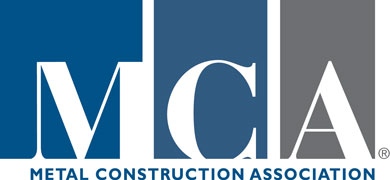
|
The Metal Construction Association’s Insulated Metal Panel Funders Group comprises leading manufacturers, resellers, and suppliers who are dedicated to growing the use of insulated metal panels (IMPs). www.metalconstruction.org |


